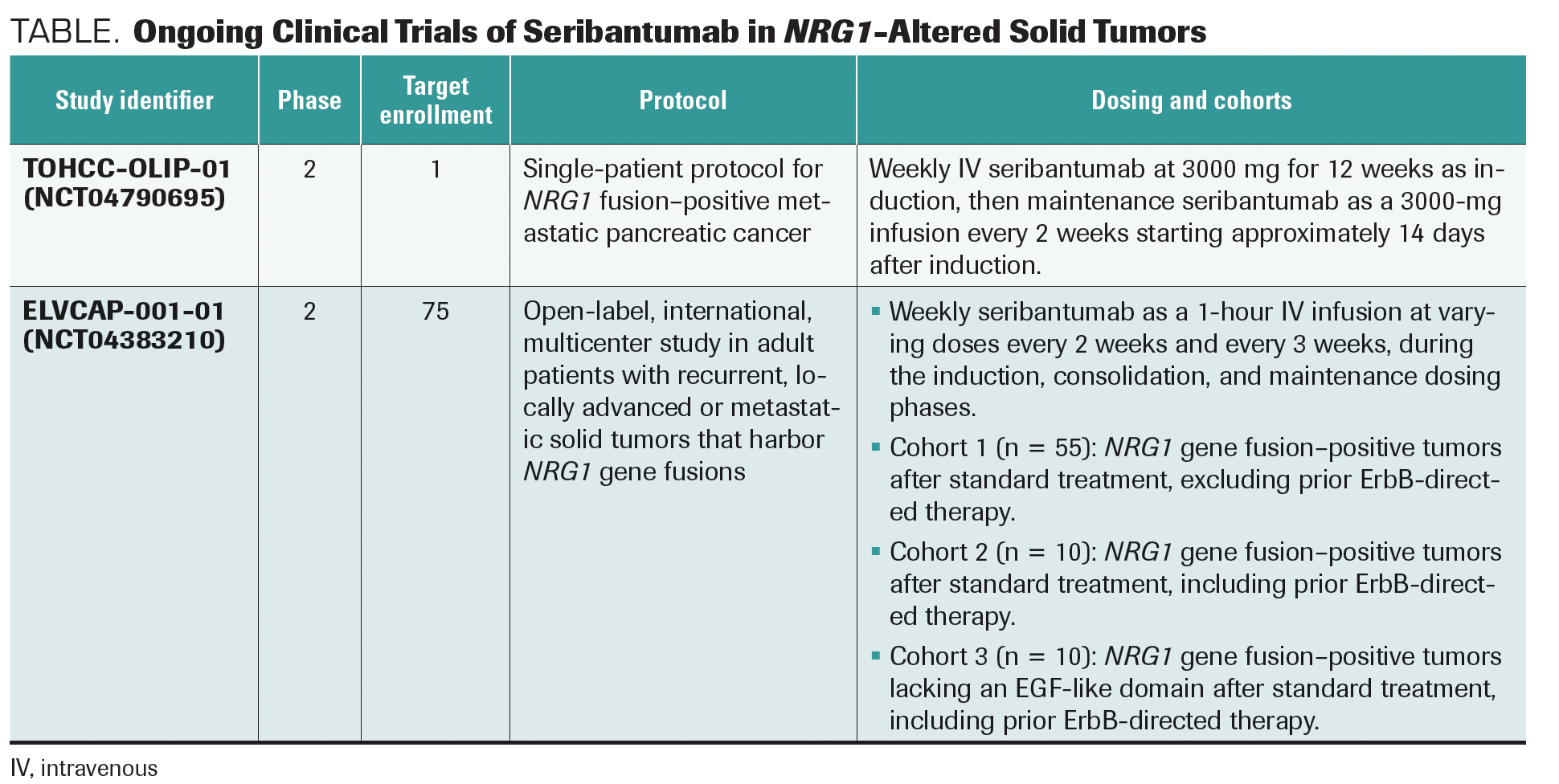Preclinical Data Show Promise of Seribantumab in HER3-Positive Cell Lines
Alexander I. Spira, MD, PhD
Virginia Cancer Specialists
Fairfax County, VA

D. Ross Camidge, MD, PhD
University of Colorado Hospital
Aurora, CO

In this edition of Between the Lines, D. Ross Camidge, MD, PhD, and Alexander I. Spira, MD, PhD, examined preclinical data for seribantumab in patient-derived cell lines with NRG1 fusions.1
These early results for the anti-HER3 antibody in NRG1-rearranged lung and breast cancer cells demonstrated the agent’s ability to inhibit growth and signaling activation of 4 ErbB family members, which led to NRG1 fusion–dependent tumorigenesis in vitro and in vivo.
What HER3 does when it’s active, explained Camidge, director of the Thoracic Oncology Clinical and Clinical Research Programs at the University of Colorado in Aurora, “is partner with different members of the family—mostly HER2, but also [sometimes] with EGFR and HER4—causing signaling, and that seems to drive some cancers.”
“You’re actually not directly targeting the NRG1, but you’re targeting its partner, HER3, which is just a different way to think about things when you think about typical targetable mutations,” responded Spira, a director of Virginia Cancer Specialists. A challenge, he added, “is that we’re looking at a very small percentage of cancer patients. Probably fewer than 1% of patients with cancer have this targetable fusion, although like most targetable mutations, when you have it, it appears to be very active.”
Evidence of Activity of Seribantumab
In the study, cancer cell lines with NRG1 fusions or amplifications were compared with cells that did not harbor any aberrations in NRG1. Results indicated that treatment with either afatinib (Gilotif) or seribantumab resulted in reduced growth of NRG1 fusion–positive cell lines in a dose-dependent manner, whereas non–NRG1-altered cell lines saw minimal effect.
Additional examination into seribantumab’s effect on NRG1-β1 in one cell line—which caused increased phosphorylation of EGFR, HER3, and HER4 receptors in a dose-dependent manner—demonstrated that inhibition of HER3 with the agent was able to efficiently block NRG1-dependent cell proliferation. Other cellular processes suggest that seribantumab induces apoptosis of NRG1 fusion–positive breast and lung cancer cell lines and can inhibit phosphorylation of downstream mediators of NRG1-altered cells.
In patient-derived xenograft models of ovarian and non–small cell lung cancer (NSCLC), tumor regression of 50% to 100% was noted with seribantumab.
In postulating how these data might translate to the clinical setting, Spira commented on the known effects of afatinib in patients. “I had to be reminded about afatinib. A lot of drugs are being studied [for treating tumors with] these NRG1 fusions, [and] we’re not hearing much about afatinib anymore. Given what we know about the toxicity of afatinib and the doses that [are being used] here, that’s probably not a sustainable dose in real life. This explains to me why, if anything, you have a better chance with seribantumab.”
Key Takeaways for the Clinic
Spira noted a key aspect of the research: the evidence of afatinib’s efficacy in NRG1-altered cell lines. “Afatinib, as a drug, has been around for a long time and has been studied typically in EGFR mutations, but we forget it’s a pan-HER drug. There is activity in these NRG1 fusions as a downstream effect. As I looked at some of the effects of it and where things are, my take-home is it might be a tough drug to give, thinking about the toxicity and the doses achievable.”
“The idea of coming at these from a different point of view with the anti-HER3 antibody is a lot more interesting,” said Camidge. “Seribantumab looks like it’s got the chops to do it; it downregulates the signaling and causes shrinkage.”
Both investigators said efficacy in patients remains to be seen, but ongoing trials are examining the use of seribantumab in patients with NRG1-altered tumors (TABLE).
TABLE. Ongoing Clinical Trials of Seribantumab in NRG1-Altered Solid Tumors

NRG1 as a Clinical Biomarker in Cancer
Alterations in NRG1 are extremely rare, accounting for only about 1% of all cases of NSCLC. However, the ability to successfully target and treat cancers with these alterations makes them important to screen for, lending greater significance to the need for genomic testing.
“It’s a reminder of the importance of next-generation sequencing. If you don’t test, you can’t find for these,” said Spira.
He cited a retrospective review presented at the 2021 American Society of Clinical Oncology Annual Meeting showing that fewer than 50% of patients with metastatic NSCLC in the US Oncology Network were tested for mutations in ALK, BRAF, EGFR, and ROS1, and for PD-L1 expression.2
“Many community-based hospitals and groups are still limiting the testing,” Spira said. “It’s important to make sure we’re testing everybody comprehensively, not just doing assays based on 1, 2, 3, or 5 [tests]. This is a reminder of how important it is to do broad-based testing.”
References
- Odintsov I, Lui AJW, Sisso WJ, et al. The anti-HER3 mAb seribantumab effectively inhibits growth of patient-derived and isogenic cell line and xenograft models with oncogenic NRG1 fusions. Clin Cancer Res. 2021;27(11):3154-3166. doi:10.1158/1078-0432.CCR-20-3605
- Robert NJ, Nwokeji ED, Espirito JL, et al; MYLUNG Consortium Collaborators. Biomarker tissue journey among patients (pts) with untreated metastatic non-small cell lung cancer (mNSCLC) in the U.S. Oncology Network community practices. J Clin Oncol. 2021;39(Suppl 15):abstr 9004. doi:10.1200/JCO.2021.39.15_suppl.9004
Editor’s Note: Interview quotes slightly modified for readability.